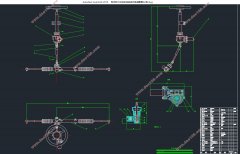燃料电池公交客车转向系设计(含CAD零件图装配图)

1.无需注册登录,支付后按照提示操作即可获取该资料.
2.资料以网页介绍的为准,下载后不会有水印.资料仅供学习参考之用.
密 惠 保
燃料电池公交客车转向系设计(含CAD零件图装配图)(任务书,开题报告,文献摘要,论文说明书11000字,CAD图纸10张)
摘要
伴随着全球能源短缺和环境污染问题的日益突出,零排放、高效率、可再生能源等成为了新能源客车未来前进的方向。作为一种新型清洁能源,燃料电池经过半个多世纪的发展和研究,技术趋向于成熟,在客车领域的应用空前飞速,受到各国政府的密切关注和相关政策的大力支持。燃料电池客车凭借能量利用率高、环境友好、续航里程长等优势成为新能源客车未来发展的方向,也是技术竞争的制高点。本课题以燃料电池客车为背景,设计客车的转向系统。此次设计采用电动助力转向系统(EPS)的方案,传统客车大多采用液压助力转向系,相比之下电动助力转向系统有效地节约能源,提高驾驶的安全性,利于环境的可持续性发展,并解决了汽车转向轻便型和灵敏性的矛盾[1]。本论文首先对EPS的发展历史和现状进行阐述,介绍EPS的基本结构和工作原理,根据基本设计参数完成电动助力转向系统相关机构的选型,然后对齿轮齿条式转向器进行设计计算和校核,最后对整个转向系统进行优化设计,完成整个系统的设计。
关键词:燃料电池客车;电动助力转向系统;齿轮齿条转向器;转向传动机构;蜗轮蜗杆减速机构 [资料来源:THINK58.com]
Abstract
With the increasing global energy shortage and environmental pollution problems, zero-emission, high-efficiency and renewable energy have become the future direction of new energy buses. As a new type of clean energy, after more than half a century of development and research, the technology of fuel cells has matured. The application in the field of passenger cars is unprecedentedly rapid and has been closely watched by governments of all countries and supported by related policies. Fuel cell buses have become the future development direction of new energy buses and the commanding heights of technological competition by virtue of high energy utilization, environmental friendliness and long mileage. This topic uses the fuel cell bus as a background to design the steering system of the passenger car. The design of the electric power steering system (EPS) was adopted in this project. Most of the traditional passenger cars use hydraulic power steering system. Compared to the hydraulic power steering system, the electric power steering system saves energy, improves driving safety, and facilitates the sustainable development of the environment and solve the contradiction between the car's steering light and sensitive. This paper first elaborates on the history and status quo of the development of EPS, introduces the basic structure and working principle of EPS, completes the selection of the relevant mechanism of the electric power steering system according to the basic design parameters, and then designs and calculates the Rack and Pinion Gearbox. Finally optimized the entire steering system design, complete the design of the entire system. [资料来源:http://THINK58.com]
Keywords: fuel cell passenger car; electric power steering system; Rack and Pinion Gearbox; steering transmission mechanism; worm gear reduction mechanism
根据给出的选题及相关的设计要求,通过大量查阅燃料电池客车转向系的资料,设计出了如下的主要参数:
整 车 质 量:1 7 0 5 k g
车长:4640mm 车宽:1690mm
车高:1935mm 轴距:2330mm
最小转弯半径:5000mm 方向盘直径:400mm
装备质量:1705kg 总质量:2700kg
轮胎规格:185R-14-8PR 轮胎压力:0.4P/MPa
前/后轮距:1450mm 方向盘圈数:3.5圈
满载载荷分配(前/后):1300/1400
[资料来源:THINK58.com]


目录
第1章 绪论 1
1.1汽 车 转 向 系 统 的 概 要 1
1.2公 交 车 转 向 系 统 的 演 变 1
1.3 E P S简介及在全球发展的演化 2
1.3.1 EPS简要介绍 2
1.3.2 E P S的优 势 2
1.3.3 E P S的发 展 与演 变 3
1.4文 章 研 究 意 义 及 相 关 内 容 概 述 3
第2章 EPS及其零部件的简介 5
2.1 EPS系统概述 5
2.1.1 EPS系 统 的 基 本 运 作 原 理 5
2.1.2 电动助力转向系统的类型 5
2.2 助力电动机的选择 6
2.2.1 电 动 机 的 简 介 6
2.2.2 电 机 相 关 参 数 的 选 择 7
2.3 电磁离合器的选择 8
2.4 扭 矩 传 感 器 的 简 介 8
第3章E P S 减 速 机 构 参 数 的 设 计 10
3.1 减速机构的简单介绍及布置方案的确定 10
3.2 蜗 轮 蜗 杆材 料 的 选 择 10
3.3 普通圆柱蜗杆传动的主要参数确定及几何尺寸计算 11
3.3.1 设 计 要 求 11
3.3.2 蜗杆传动种类的确定 11
3.3.3 蜗杆模数及分度圆直径的确定 11
3.3.4 蜗杆与蜗轮的主要参数及几何尺寸的确定 13
3.4 蜗轮齿根弯曲疲劳强度的校核 14
3.5 蜗杆轴的设计及校核 15
3.5.1 蜗杆轴的设计 15
3.5.2 蜗 杆 轴 键 的 参 数 设 定 16
3.5.3 蜗 杆 轴 的 校 核 17
第4章 齿轮齿条式转向器的设计 20
4.1 齿轮齿条式转向器的概述 20
4.1.1 齿轮和齿条的概述 20
4.1.2 设计要求 20
4.2 齿轮齿条材料的选择与参数的确定 20
4.2.1材料的选择 20
4.2.2 计算许用应力 21
4.2.3 初步确定齿轮的基本参数的主要尺寸 22
4.2.4 确定齿轮传动主要参数的几何尺寸 23
4.2.5 齿轮强度校核 24
4.3 齿轮轴的参数设计与校核 24
4.3.1 轴的基本参数的设计与计算 24
4.3.2 轴的校核 25 [来源:http://think58.com]
第5章 转向传动机构的布置形式 27
5.1转向传动机构的作用 27
5.2 与不同悬架配用的转向传动机构 27
5.2.1 与非独立悬架配用的转向传动机构 27
5.2.2 与独立悬架配用的转向传动机构 29
5.3 转向节 29
5.3.1 主销后倾角 30
5.3.2 主销内倾角 30
参考文献 31 [资料来源:THINK58.com]
上一篇:燃料电池客车制动系统设计(含CAD零件图装配图,CATIA三维图)
下一篇:中型轿车前轮制动器设计(含CAD零件图装配图,CATIA三维图)
